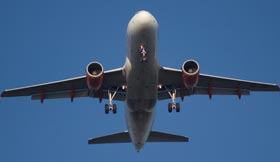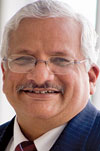

Today, over eight million people take to international travel every day, taking off and landing at hundreds of airports flying scores of airlines. Unfortunately lurking among them could be a handful of illegal immigrants, victims of human trafficking, gangs involved with organised crime and smuggling, and perhaps what have come to be perceived as the most dangerous of them all – terrorists.

It has now been over 40y years ago that elementary metal detectors were first introduced at airports for checking passengers, based on the premise that weapons and explosives would invariably show up if these were being carried on the body of any individual.
Today, detection of many other types of dangerous materials is effectively possible and is being routinely done, but also at the same time – the sheer numbers and the costs involved is leading agencies and governments to look at other viable strategies in combating this evil that seems to become more ominous with each passing year, as more groups in society strive to use violence as a means of seeking national and international recognition for themselves.
Airlines already pay nearly 9 Billion US Dollars annually to meet the essential aviation and border security requirements. This is in addition to what governments, regulators, airports and other key-stakeholders spend on related costs, and is already an area calling for substantially greater coordination and collaboration. There is significant discussion on aspects such as cost-benefit and in the end, as to who pays. In another 10 years or less, the number of international passengers is set to double, and the expenditure on security rise multi-fold, if the current practices are continued without significant change. So what are the alternatives?
For example IATA (International Air Transport Association having 260 member airlines) places more focus on outcomes from threat-based risk management, than on implementation of control measures. Along with ICAO (International Civil Aviation Organisation, having 191 member countries) and WCO (World Customs Organisation, having 179 member countries) these organisations provide the multilateral framework within which this security agenda has been discussed for many years now.
Solutions and more challenges
Among the problem areas at the policy level, has been getting to a greater recognition between airlines and states regarding responsibilities and allocation of resources. However, with greater collaboration the elimination of redundant and duplicate requirements is being gradually achieved with an understanding that greater interdependence will have to be relied on in the coming years, while recognising that states and organisations will often have vastly different resources to deploy. In technological terms, it also means that often disparate and often incompatible systems will need to work together, or will need a substantial overhaul. Thus, while the directions seem clearer, the problems look more challenging than ever before.
In all this, quick and intelligent analysis of passenger data seems to be a promising new area that has been getting significant attention. This is reflected in the biggest security programme for civil aviation which was formerly known as ‘Checkpoint of the future’ being renamed as ‘Smart security’.
The key differences that need to be highlighted are that the new approach is likely to be more evolutionary and innovative, based on passenger differentiation and has a more sophisticated understanding of unpredictability. The three pillars of ‘smart security’ therefore are: focusing security resources where the risk is, advancement of screening technology and finally, process innovation. The objectives are to achieve by 2020, passenger-flow with minimum interruption and waiting time, with risk-based screening when and where a potential threat is identified.
Smart security also marks a shift from being an IATA (and thus airline) led initiative to one being industry-led with strong government participation. As on date, the most substantial pilots are underway at Heathrow in London and Schiphol in Amsterdam. This is being complemented with a long-term initiative called the SeMS (Security Management Systems) which aims at evolving national aviation security policies as well as the efforts of the airlines and airports to usher in a risk-based framework within their respective security cultures.
Data analytics
The data analytical tools in place today revolve around the two fundamental data sets that the aviation industry deals with: the API and the PNR.
API (Advance Passenger Information) is essentially the bio-data from the passengers’ passports that are captured by the airlines and then transferred to the government authorities. However, this process varies substantially in its implementation. In its simplest form, the data is transferred in batch before a flight and may only be filed. In the case of MH370 if the API had been scrutinised closely, the two persons travelling on false passports could have been apprehended before boarding.
However some countries do scrutinise such data online (known as iAPI, APP or AQQ) and even South Africa has a system in place that was implemented for the 2010 FIFA World Cup whereby known persons with established criminal records were prevented from boarding flights into the country. It is expected that such systems will become more prevalent in the coming times. With increasing implementation of the electronic passport, the scrutiny could include biometrics. However, a lot of effort is still required for standardisation among governments as well as airlines and airports, and must meet requirements of all three: security, immigration and customs.
PNR (Passenger Name Record) is actually an older data set, primarily emerging out of the ticket purchase and flight booking and belongs to airlines, or actually the passenger reservation systems. In the realm of security this data is considered sensitive and involves privacy issues. The data standards for PNR vary widely, and most governments are still to develop an interface with such data.
Also there exist no multilateral arrangements that could serve as a platform for evolving this. However, a start has been made by IATA in developing a standard format based on anticipated government requirements (PNRGOV) but is yet to be widely endorsed. Currently some exchange of PNR data exists between the USA and the EU under a bilateral understanding and this model is being endorsed by some other countries as well.
While all this might call for the major overhaul of the computerised systems within the aviation industry and its ownership, new software systems are already on the horizon – and those evincing the most interest and curiosity are the ones that can analyse the data of the individual’s travel habits and movements – frequent changes in itinerary, visits to particular places, methods of payment, airlines and interchange points, car-hire and hotels – all that could give vital clues and thus help avert terror action affecting thousands of lives.
Also, the airport of tomorrow will be increasingly dependent on self-service gates that use combinations of such software systems and biometrics. Such gates that are being piloted at most major international airports will also be the gateways for the regular passengers for quick and trouble-free entry and exit at borders under Registered Traveller Programs (RTP) on a much larger scale in the near future. But then, these too need to be well-guarded against those looking for that little loophole that might allow a criminal to slip past. There will also be the extreme situations that need to be catered for like seasonal huge influx during vacations; asylum seekers as well as the Visa overstay situations.
However, it all does mean that newer and more powerful and integrated systems will need to be put in place, as well as systems and technologies will need to be constantly innovated and evolved, so as to stay ahead, and thus make our international air travel as safe as possible.
© Technews Publishing (Pty) Ltd. | All Rights Reserved.